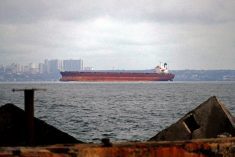Initial reaction to the Canadian Transportation Act review report is that it falls far short of fixing what’s broke with the grain transportation system.
Farmers are worried about recommendations to phase out the Maximum Revenue Entitlement (MRE) over seven years and shorten interswitching access. But they welcome proposals to improve the MRE in the interim, extend shipper protection to producer cars and enhance short line railways.
The Western Grain Elevator Association (WGEA), which speaks for the major grain companies, is reserving comment until it has studied the report. However, according to a well-placed source, the WGEA is deeply disappointed.
Read Also

Mazergroup’s Bob Mazer dies
Mazergroup’s Bob Mazer, who helped grow his family’s company into a string of farm equipment dealerships and the main dealer for New Holland machinery in Saskatchewan and Manitoba, died July 6 from cancer.
Farmers are also welcoming news that Transport Minister Marc Garneau wants to consult further before acting on the report.
While in opposition, veteran Saskatchewan Liberal MP Ralph Goodale was a strong advocate for the MRE, also known as the revenue cap, and other shipper protections, but whether his views are shared by the new Liberal government is unknown. It has lots of wiggle room, given the report was prepared by people appointed by the former Conservative government.
While the report acknowledges grain shippers’ complaints about poor rail service, it doesn’t recommend regulatory solutions, including the reciprocal penalties grain companies want the railways to pay when they fail to live up to service agreements.
The report, overseen by former Liberal and then Conservative cabinet minister David Emerson, examines all components of Canada Transportation Act, not just grain moved by rail. It proposes level of services provisions “be amended to recognize shippers and their collective needs, in the context of the optimal performance of the freight rail system…”
That sounds promising, but then the report adds: “This means that the railways must meet the needs of shippers in consideration of the ongoing fluidity of the rail network and health of the Canadian economy.”
Tying the well-being of the economy to shipper complaints will make it harder than it is now to penalize the railways for poor service, the source said.
Mimic competition
The WGEA, like most farm groups, has maintained the MRE is necessary so long as grain shippers are captive to the railways and competition is lacking.
“If the Maximum Revenue Entitlement goes, grain companies want provisions that force market discipline on the railways or at least mimic competition,” the source said.
The MRE was established in 2000 in recognition that the railways don’t compete, after the railways rejected a plan for open running rights.
“The eventual elimination of the Maximum Revenue Entitlement will finally place the grain sector on an equal footing with all other commodities transported by rail in Canada,” the report says. “Finally, an unfettered commercial framework provides greater assurance that supply chain partners that handle and transport grain will invest in innovative supply chain solutions to move grain efficiently in years to come.”
However, the report doesn’t explain how eliminating the MRE will accomplish that. The WGEA and most farm groups say without the MRE, they’ll pay more to ship grain and get the same inadequate service. That’s what they see now where the MRE doesn’t apply.
The MRE gives the railways rate-setting flexibility, but sets a maximum amount they can earn hauling grain, while guaranteeing them fair return. The railways claimed the MRE would be moot because they’d be well under it due to competition. In fact they are at or near the maximum almost every year, which groups point to as evidence of a lack of competition.
Defending MRE
In news releases the Keystone Agricultural Producers (KAP), Alberta Wheat Commission (AWC), Western Canadian Wheat Growers Association (WCWGA) and Western Barley Growers Association, defend retaining the MRE.
“I was on a subcommittee of the Crop Logistics Working Group, a national committee of stakeholders that developed a submission for the review, and we strongly recommended the MRE be maintained because it’s working just as it’s supposed to,” KAP president Dan Mazier said.
“We believe the elimination of the MRE will impose higher costs on farmers with no evidence it will lead to better service,” said AWC chair Kevin Auch. “This is important for our industry when there are only two major players.”
The four groups also oppose the report’s recommendation to allow interswitching distances to go back to 30 kilometres from the current 160, contending the change will reduce competition between railways.
The WGEA is also on record as supporting continuing interswitiching at 160 kilometres. It’s a valuable competitive tool grain shippers are using and want to keep, executive director of WGEA Wade Sobkowich said in an interview Feb. 10.
There’s more interswitching occurring than many people expected, Canada’s grain transportation monitor, Mark Hemmes, president of Quorum Corporation, said last month.
Interswitching
The Conservative government extended interswitching to 160 kilometres from 30 in Bill C-30, the Fair Rail for Farmers Act, but the provision is set to end Aug. 1 because it was part of emergency legislation it passed in response to a huge backlog in grain shipments in 2013-14.
The review panel report says according to the Canadian Transportation Agency (CTA) “very few shippers have availed themselves of the extended limits to date, thus it is expected there will be little impact if they are ‘sun-setted.’
But Sobkowich said last month at least three grain companies use interswitching regularly.
“Expanded interswitching is an important thing,” he said.
“Companies are using it from certain locations and it also begins a dialogue in some cases where in the end of discussion they end up staying with the primary carrier. But they are getting better service or better rates out of that location. It would be a step backwards to lose it.”
Interswitching allows an elevator within 160 km of an interchange with a competing railway to strike a deal with that firm to ship its grain. If it does, the elevator’s local railway is obliged to pick up empty cars from the competing company and spot them. After they’re filled the local railway must return them to the competing railway, which takes them to their destination.
The Agricultural Producers Association of Saskatchewan wants Ottawa to fulfil its election promise to review the railways’ cost for shipping grain to ensure what farmers pay and what the railways receive, is fair.
There are things in the report farmers like, said KAP’s Dan Mazier, including recommendations to extend shipper protection to producer users and modifying federal infrastructure programs to allow short line railways to apply for funding directly, without a government sponsor.
The WCWGA association supports modifying the MRE so it better reflects individual railway costs. The chance would encourage more railway investment.
The WGEA also likes the recommendation to allow the railways to offer grain shipping outside the MRE. However, one industry official said he fears that’s a slippery slope that will shift resources eventually killing the MRE.
Conservative Agriculture Critic Chris Warkentin is urging the government to act on the report, but in a news release he doesn’t spell out what recommendations the Conservatives support or oppose.




















